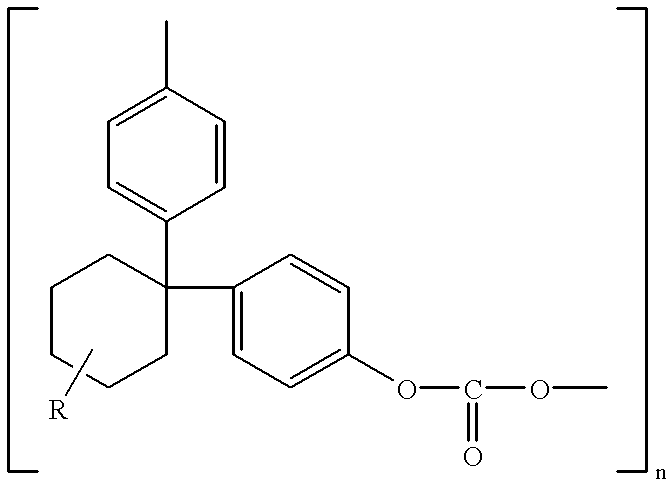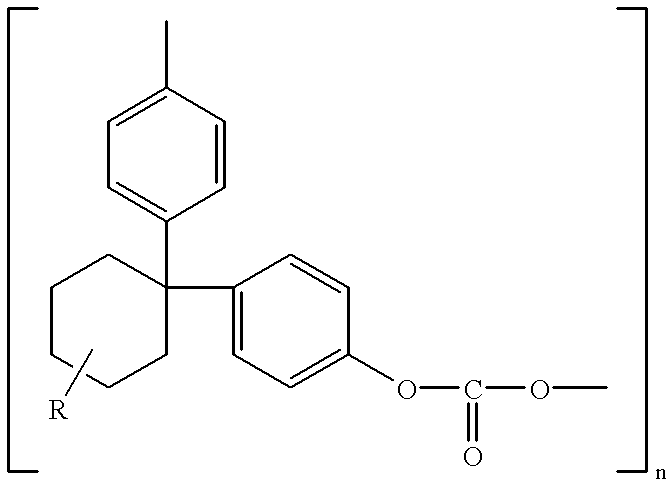Polycarbonate electrolyte, the preparation thereof and polymer lithium batteries containing the same
- Summary
- Abstract
- Description
- Claims
- Application Information
AI Technical Summary
Benefits of technology
Problems solved by technology
Method used
Image
Examples
example 2
Preparation of Polycarbonate Electrolyte
3 g of polycarbonate (Mitsubishi Engineering Plastics Co. Ltd., Japan, PCZ-300), 0.6 9 of silicon dioxide, and 3 g, 1.5 g and 0 g of dibutyl phthalate were mixed with 32 g of methylene chloride, and stirred to obtain colloidal solutions. The colloidal solutions were coated onto plastic sheets by using a doctor blade having a gap of 400 micrometer. The coated sheets were then kept at an ambient of 15-40.degree. C. for a sufficient period of time to evaporate the methylene chloride to obtain polycarbonate membranes containing dibutyl phthalate. The polycarbonate membranes were then peeled off from the plastic sheets and immersed in diethyl ether for 20 minutes to extract the dibutyl phthalate. Sponge-like, porous and dibutyl phthalate-free polycarbonate membranes were then obtained. The obtained sponge-like polycarbonate membranes were then impregnated with an electrolytic solution containing propylene carbonate, ethylene carbonate (1:1(v / v)) an...
example 3
Preparation of Polycarbonate Electrolyte
3 g of polycarbonate (Mitsubishi Engineering Plastics Co. Ltd., Japan, PCZ-300), 0.6 g of silicon dioxide, and 3 g, 1.5 g and 0 g of propylene carbonate were mixed with 32 g of methylene chloride, and stirred to obtain colloidal solutions. The colloidal solutions were coated onto plastic sheets by using a doctor blade having a gap of 400 micrometer. The coated sheets were then kept at an ambient of 15-40.degree. C. for a sufficient period of time to evaporate the methylene chloride to obtain a polycarbonate membrane containing dibutyl phthalate. The polycarbonate membrane was then peeled off from the plastic sheets and immersed in diethyl ether for 20 minutes to extract the dibutyl phthalate. Sponge-like, porous and dibutyl phthalate-free polycarbonate membranes were then obtained. The obtained sponge-like polycarbonate membranes were then impregnated with an electrolytic solution containing propylene carbonate, ethylene carbonate (1:1(v / v)) a...
example 4
Preparation of a Lithium Battery
(a) Preparation of an Cathode
85 g of LiCoO.sub.2, 5 g of polyvinylidene fluoride / hexafluoropropylene binder (Solvay, USA, Cat. No. SOLEF 20810), and 10 g of conductivity aid (Timcal Ltd., Switzerland, Cat. No. KS-6) were poured into a mixed solvent of acetone / dibutyl phthalate solvent (25.5 g / 2.5 g) and stirred with a magnetic stirrer for 30 minutes to obtain a slurry. The slurry was then coated onto the two sides of several aluminum nets (Fukuda metal Co., Ltd, Japan) by using a doctor blade having a gap of 250 .mu.m. The coated nets were then kept at room temperature for a period of time sufficient to evaporate acetone. These coated nets were then calendered under a pressure of 2000 kg / cm.sup.2 to form the laminated cathode.
(b) Preparation of an Anode
95 g of mesophase carbon microbeads (MCMB), 5 g of polyvinylidene fluoride / hexafluoropropylene binder (Solvay, USA, Cat. No. SOLEF 20810), and 10 g of conductivity aid (Timcal Ltd., Switzerland, Cat. No...
PUM
| Property | Measurement | Unit |
|---|---|---|
| Angle | aaaaa | aaaaa |
| Thickness | aaaaa | aaaaa |
| Thickness | aaaaa | aaaaa |
Abstract
Description
Claims
Application Information
 Login to View More
Login to View More - R&D
- Intellectual Property
- Life Sciences
- Materials
- Tech Scout
- Unparalleled Data Quality
- Higher Quality Content
- 60% Fewer Hallucinations
Browse by: Latest US Patents, China's latest patents, Technical Efficacy Thesaurus, Application Domain, Technology Topic, Popular Technical Reports.
© 2025 PatSnap. All rights reserved.Legal|Privacy policy|Modern Slavery Act Transparency Statement|Sitemap|About US| Contact US: help@patsnap.com



